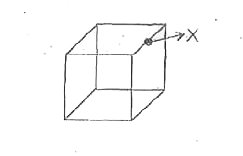The number of atoms in bcc and fcc arrangement are respectively :
1,2
2,4
4,2
2,1
The correct Answer is:B
To determine the number of atoms in body-centered cubic (BCC) and face-centered cubic (FCC) arrangements, we can follow these steps:
Step 1: Understanding BCC Structure
- In a BCC unit cell, there is:
- 1 atom at the center of the body.
- 8 atoms at the corners of the cube.
Step 2: Contribution of Atoms in BCC
- The contribution of the atom at the center is 1 (since it is not shared).
- The contribution of each corner atom is 18 (since each corner atom is shared by 8 unit cells).
- Total contribution from corner atoms:
8 corners×18=1 atom
- Therefore, the total number of atoms in a BCC unit cell is:
1 (center)+1 (from corners)=2 atoms
Step 3: Understanding FCC Structure
- In an FCC unit cell, there is:
- 6 atoms at the face centers.
- 8 atoms at the corners of the cube.
Step 4: Contribution of Atoms in FCC
- The contribution of each face-centered atom is 1 (since it is not shared).
- The contribution of each corner atom is 18.
- Total contribution from face-centered atoms:
6 faces×1=6 atoms
- Total contribution from corner atoms:
8 corners×18=1 atom
- Therefore, the total number of atoms in an FCC unit cell is:
6 (from faces)+1 (from corners)=4 atoms
Final Answer
- The number of atoms in BCC is 2.
- The number of atoms in FCC is 4.
Summary
Thus, the respective number of atoms in BCC and FCC arrangements are 2 and 4.
---
- In a BCC unit cell, there is:
- 1 atom at the center of the body.
- 8 atoms at the corners of the cube.
- The contribution of the atom at the center is 1 (since it is not shared).
- The contribution of each corner atom is 18 (since each corner atom is shared by 8 unit cells).
- Total contribution from corner atoms:
8 corners×18=1 atom
- Therefore, the total number of atoms in a BCC unit cell is:
1 (center)+1 (from corners)=2 atoms
- In an FCC unit cell, there is:
- 6 atoms at the face centers.
- 8 atoms at the corners of the cube.
- The contribution of each face-centered atom is 1 (since it is not shared).
- The contribution of each corner atom is 18.
- Total contribution from face-centered atoms:
6 faces×1=6 atoms
- Total contribution from corner atoms:
8 corners×18=1 atom
- Therefore, the total number of atoms in an FCC unit cell is:
6 (from faces)+1 (from corners)=4 atoms
- The number of atoms in BCC is 2.
- The number of atoms in FCC is 4.
Thus, the respective number of atoms in BCC and FCC arrangements are 2 and 4.
Topper's Solved these Questions
- BOOK - MODERN PUBLICATIONCHAPTER - SOLID STATEEXERCISE - COMPETITION FILE - OBJECTIVE TYPE QUESTIONS (B. MULTIPLE CHOICE QUESTIONS)18videos
SOLID STATE
- BOOK - MODERN PUBLICATIONCHAPTER - SOLID STATEEXERCISE - COMPETITION FILE - OBJECTIVE TYPE QUESTIONS (B. MULTIPLE CHOICE QUESTIONS)(JEE(MAIN) & OTHER STATE BOARDS ENGINEERING ENTRANCE)32videos
SOLID STATE
- BOOK - MODERN PUBLICATIONCHAPTER - SOLID STATEEXERCISE - HOTS - HIGHER ORDER THINKING SKILLS (ADVANCED LEVEL)12videos
SOLID STATE
- BOOK - MODERN PUBLICATIONCHAPTER - POLYMERSEXERCISE - Competition file (OBJECTIVE TYPE QUESTIONS) (C. MULTIPLE CHOICE QUESTIONS)(Integer Type Questions)6videos
POLYMERS
- BOOK - MODERN PUBLICATIONCHAPTER - SOLUTIONSEXERCISE - UNIT PRACTICE TEST14videos
SOLUTIONS
Similar Questions
Knowledge Check
- Question 1 - Select One
Number of atoms in fcc unit cell is
A1B2C3D4 - Question 2 - Select One
The number of atoms per unit cell in bcc lattice is
A1B2C4D9 - Question 3 - Select One
What is the coordination number of atoms in bcc, hcp and ccp and simple cubic lattices?
A8, 12, 12, 6B6, 12, 12, 8C12, 6, 8, 12D12, 12, 8, 6
The number of atoms per unit cell in bcc lattice is
View SolutionThe site labelled as 'a' in fcc arrangement is
 View Solution
View SolutionPercentage of empty space in a bcc arrangement is :
View SolutionThe site labelled as 'X' in fcc arrangement is
 View Solution
View SolutionNa and Mg crystallize in bcc- and fcc-type crystals, the ratio of number of atoms present in the unit cell of their respective crystal is
View Solution

